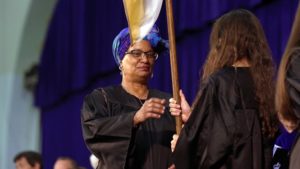
Mélisande Short-Colomb’s great-grandmother Mary Ellen Queen was sold in 1838 to help a struggling Georgetown University.
Days into her freshman term at Georgetown University, Mélisande Short-Colomb describes herself as “a somewhat disadvantaged student.” “I’m 63 years old. I don’t have accumulated wealth. I’m a Black woman from New Orleans, Louisiana,” said the new student.
Additionally, her new school sold one of her relatives.
Short-Colomb’s great-grandmother Mary Ellen Queen was one of 272 enslaved Black people sold to Louisiana plantations in 1838. Two Georgetown presidents, who were also Jesuit priests, helped broker the sale, and the floundering school used the funds to pay off sizable debts. 179 years later, the Washington, D.C. university is one of the most prestigious, and expensive, academies in the land, touting former President Bill Clinton and hoops legend Allen Iverson as Hoya alumni.
Although Georgetown holds a bill of sale for her great-grandmother, Short-Colomb recognizes the slave trade is beyond one school and doesn’t single out Georgetown. She also indicts “Harvard, Yale, Princeton, Johns Hopkins, the University of Chicago, Ole Miss, Louisiana State University, Georgia Tech, New York Life [Insurance Company] and all of the systems that go into this American life that have contributed to human trafficking, slavery, and the continued disenfranchisement” of Black people.
For a time, Georgetown seemed to separate itself from other institutions by acknowledging past wrongs. In 2016, school President John DeGioia offered a “journey of reconciliation.” He affirmed that the university enslaved Black people and said the school “cannot do our best work if we refuse to take ownership of such a critical part of our history. We must acknowledge it.”
President DeGioia repeated Georgetown’s commitment to engaging and working with the descendants of those 272 sold Black people. His pledge also included preferential admissions status for the descendants. However, Short-Colomb insisted the university never reached out to her or any of the other descendants. The near retirement age freshman said, “Sweetie, Georgetown has had this story for 200 years. They could have done a whole lot in 200 years. Why would they all of a sudden start running after descendants now? They never tried to find descendants in the past.”
In fact, the Georgetown Memory Project, not the university, informed Short-Colomb of her peculiar relationship to the school. Founded by Richard Cellini, the GMP is “an independent tax-exempt organization founded by friends, allies, and alumni of Georgetown University.” They’re not financed or governed by the school. Cellini told CBC Radio he was spurred to research when the university stonewalled his inquiries about the 1838 sale.
“I contacted Georgetown and I said what happened to the slaves, and they told me that the university had looked into it a couple of years ago and discovered that they all quickly died. Within a couple of weeks of landing in Louisiana, they all died of a mysterious fever and left no trace and no descendant,” said Cellini, a white attorney.
To the contrary, Cellini and the GMP found that many of the parceled Black people survived the Louisiana sugar cane and even had children. As of September 2017, the Georgetown Memory Project has located more than 5,000 direct descendants of the 1838 group.
When asked if the university should offer enrollment and scholarships to the descendants of Georgetown’s Black “property,” Cellini prefaced his response by saying, “At every step along the way, the Georgetown slaves secured the future of the university. They built the university, they sustained it, and finally, in 1838, they rescued it.”
Founded in 1789, Georgetown charged no tuition during the first fifty years of operation. Cellini concludes Black bondage subsidized free education for generations of white students, “So it’s absolutely right that Georgetown should extend scholarships to descendants of the Georgetown slaves.”
Evidence suggests the university’s extension has been paltry. Short-Colomb brandishes a mishmash of student loans, a Pell Grant, work-study, and scholarships to pay for her top-notch education. Atonement didn’t include free education for the great-granddaughter of Mary Ellen Queen.
The school has done so little to encourage the thousands of Black descendants to obtain a Georgetown education that Short-Colomb is one of only two descendants currently enrolled. This January, Elizabeth Thomas will join her brother, Shephard Thomas, and Short-Colomb to make three. Last month, Elizabeth noted the school’s scarce effort to solicit Black descendants, telling NPR, “I thought it was interesting that there is nowhere on the application to put that you are a descendant. So the fact that they’re saying they’re giving us, you know, preferential admittance, how do you know that I even am a descendant if it’s nowhere on the application to put that?”
Atlanta Black Star asked for Short-Colomb’s view on what Georgetown should do to compensate for its investment in Black enslavement. As opposed to a tuition break or free textbooks for herself, she hoped the university would bolster education for Black students in Louisiana. “I’d like to see them invest in Wi-Fi in a high school in Maringouin, Louisiana where 900 of the 1200 people who live in that little town are descendants of 272 people that they sold. Those people were dropped off in Maringouin 180 years ago, and they’re still there.”
Like many slaveholders, Georgetown officials maintained immaculate records of the sale and dispersal of the 272 Black people who were abandoned in Louisiana. Preserved eyewitness testimony describes the transaction that resuscitated the university: “The enslaved were grandmothers and grandfathers, carpenters and blacksmiths, pregnant women and anxious fathers, children and infants, who were fearful, bewildered and despairing as they saw their families and communities ripped apart by the sale of 1838.”
Black anguish helped propel Georgetown and numerous other institutions to their current financial prominence. Like other institutions, Georgetown’s debt to Black people remains incalculable and unpaid.
—————–
Gus T. Renegade hosts “The Context of White Supremacy” radio program, a platform designed to dissect and counter racism. For nearly a decade, he has interviewed and studied authors, filmmakers and scholars from around the globe.


